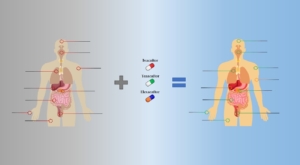Miquéias Lopes-Pacheco, PI at the Cystic Fibrosis Research Group – Functional Genomics and Proteostasis Group, at Ciências ULisboa, is the responsible author of a new review paper published in Pharmaceuticals. On this publication, the research team collected data from clinical trials of patients with Cystic Fibrosis (CF) using a combination of three drugs, showing a significant decrease in disease symptoms like pulmonary and gastrointestinal manifestations as well as pancreatic insufficiency. Find out how can this publication can give useful insights to the CF research field.
What is the current state-of-art of your research field and why do you think it was relevant to publish this review now?
The triple combination of CFTR modulators composed of Elexacaftor, Tezacaftor, and Ivacaftor is currently the most effective therapy targeting the underlying defect in people with cystic fibrosis (CF) carrying the most prevalent F508del mutation. In this review, we have collected information of most clinical studies (among randomized trials, case reports, observational and real-life studies) demonstrating the ability of this therapy in reducing pulmonary and gastrointestinal manifestations, sweat chloride concentration and pancreatic insufficiency, among other disease signs and symptoms in both short- and long-term (up to two years of follow-up to date). Furthermore, the most relevant therapy-related adverse effects have been summarized.
On what extent can this publication be important in your scientific area?
We expect that this review will be useful for everyone, including clinicians, researchers, caregivers, and patients, who are interested in understanding the therapeutic and adverse effects related to elexacaftor-tezacaftor-ivacaftor therapy.
How have your particular research contributed to the field?
We have been investigating the in vitro efficacy of clinically approved modulator drugs for rare CFTR mutations in order to identify those which may be rescued by this therapy. In parallel, our group has been focused on the identification of novel compounds able to rescue CFTR folding (correctors) and function (potentiators).
What are the future perspectives in the field? Is your team working in some of them?
The CF therapeutic development landscape continues to expand. We and other groups have been working on the development of novel therapies, and it is expected that some of these will achieve the clinical stage. This is fundamental not only to provide more robust therapeutic outcomes for people with CF who already benefit from modulator therapies but also to have alternative options for those who may not benefit from these therapies.
Discover more about Miquéias Lopes-Pacheco’s research here.
Get to know the Functional Genomics and Proteostasis Group here.
Read the full paper here.

Figure summary – Cystic fibrosis (CF) is a genetic disease with a multiorgan involvement (red bullets). The triple combination of CFTR modulators composed of Elexacaftor, Tezacaftor, and Ivacaftor significantly reduces disease symptoms and improves clinical outcomes (green bullets) for a large number of people with CF. However, some therapy-related adverse effects have also been reported (yellow bullets).


